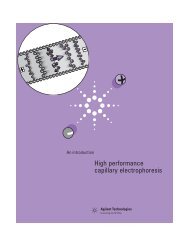<strong>HPLC</strong> <strong>Column</strong> <strong>Selection</strong> <strong>Guide</strong>linespH and Mobile PhaseThe choice of mobile phase for a reversed-phase system starts with selecting the organicmodifier. Selectivity differences and sample retention will vary significantly among mobilephases containing acetonitrile, methanol, and tetrahydrofuran (THF). Sample solubility is likelyto differ in such solvents and dictate use of a specific solvent or solvents. UV detection atcertain wavelengths is not possible with certain modifiers (e.g., methanol at 200 nm).Both pH and ionic strength of the aqueous portion of mobile phases are important parametersin developing rugged methods that are not sensitive to small variations in conditions. Withionic compounds, retention of typical species shows significant changes with pH. It is veryimportant to control pH in such reversed-phase systems to stabilize retention and bandspacing. A pH set between 2 and 4 generally provides the most stable conditions for retentionvs. small changes in pH, and this pH is recommended for starting method development formost samples, including basic compounds and typical weak acids.<strong>HPLC</strong> <strong>Column</strong>StationaryPhase<strong>Column</strong>DimensionsType ofSurfacePore SizeParticleSizeLengthInnerDiameterChemical PropertiesChemical Lifetime/SelectivityRetention FactorPhysical PropertiesEfficiencySensitivitySpeed10 Order online at www.agilent.com/chem/store
<strong>HPLC</strong> <strong>Column</strong> <strong>Selection</strong> <strong>Guide</strong>linesQuick <strong>Guide</strong> to USP Designationsfor <strong>HPLC</strong> <strong>Column</strong>sThe US Pharmacopeia (USP) is a standard source for many pharmaceutical methods.The USP specifies columns by packing materials rather than by manufacturer. The USP hasupdated its L1 definitions. Listed below you will see the most recent definitions and columnsthat apply and can be found in this column selection guide. Rapid Resolution High Throughput(RRHT) columns are now choices in the L1, L7, and L11 categories.For a complete listing of USP Designations, see <strong>Agilent</strong>'s 2009-2010 EssentialChromatography and Spectroscopy Catalog, publication number 5989-9611EN.USPDesignations USP Packing Materials <strong>Column</strong>sParticleSize (µm)PoreSize (Å)L1Octadecyl silane chemically bonded to porous silica orceramic micro-particles, 1.5 to 10 µm in diameterZORBAX Eclipse Plus C18ZORBAX Eclipse Plus XDB-C18ZORBAX SB-C18ZORBAX Extend-C18ZORBAX Rx-C18ZORBAX ODSZORBAX ODS ClassicL3 Porous silica particles, 5 to 10 µm in diameter ZORBAX SilZORBAX Rx-SilL7L8L10L11Octyl silane chemically bonded to totally porous microsilicaparticles, 1.5 to 10 µm in diameterAn essentially monomolecular layer of aminopropyl-silanechemically bonded to totally porous silica gel support,10 µm in diameterNitrile groups chemically bonded to porous silica particles,3 to 10 µm in diameterPhenyl groups chemically bonded to porous silica particles,1.5 to 10 µm in diameterZORBAX Eclipse Plus C8ZORBAX Eclipse XDB-C8ZORBAX SB-C8ZORBAX Rx-C8ZORBAX C81.8, 3.5, 51.8, 3.5, 5, 71.8, 3.5, 5, 71.8, 3.5, 5, 73.5, 53.5, 5, 75551.8, 3.5, 51.8, 3.5, 5, 71.8, 3.5, 5, 71.8, 3.5, 5, 759580808080707095808080709580808070ZORBAX NH2 5 70ZORBAX Eclipse XDB-CNZORBAX SB-CNZORBAX CNZORBAX PhenylZORBAX SB-PhenylZORBAX Eclipse XDB PhenylZORBAX Eclipse Plus Phenyl-Hexyl3.5, 53.5, 53, 551.8, 3.5, 53.5, 51.8, 3.5, 580807070808095Order online at www.agilent.com/chem/store11
















